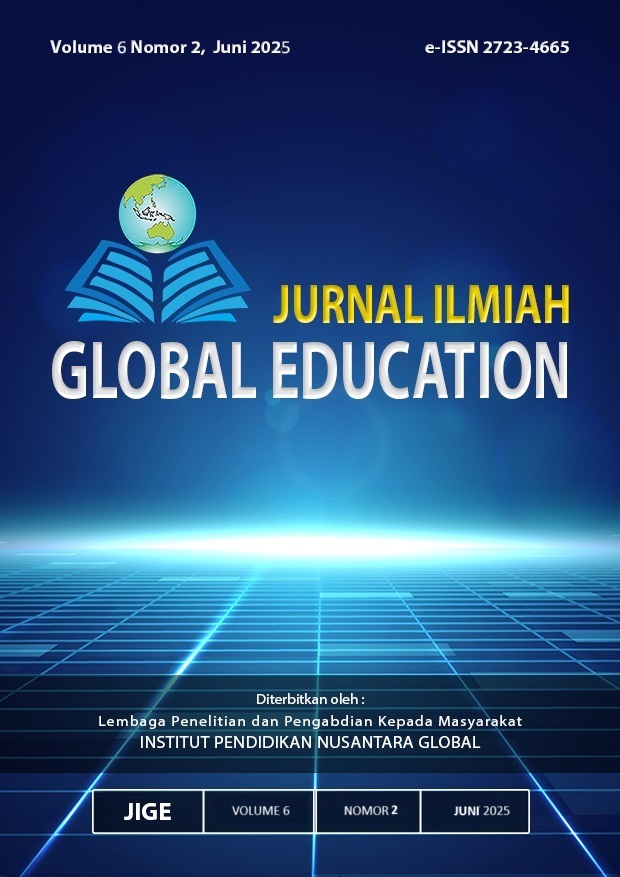Students' Perception of Socio-Affective Impacts of Translanguaging in EFL Classroom
DOI:
https://doi.org/10.55681/jige.v6i2.3960Keywords:
translanguaging, students’ perception, EFL classroom, language pedagogyAbstract
This qualitative study explores students' perceptions of translanguaging in the English as a Foreign Language (EFL) classroom context at Universitas Khairun. Drawing on semi-structured interviews with three undergraduate students, this research examines the roles, benefits, and challenges of using multiple languages (English, Bahasa Indonesia, and Melayu Ternate) in the classroom. Findings reveal that varying emotional responses, such as pride, confusion, and self-consciousness, emerge as translanguaging effects. Triangulation with faculty perspectives confirms translanguaging as an inclusive, efficient, and strategic pedagogical practice. The study concludes that translanguaging is a beneficial approach in multilingual EFL contexts to support deeper engagement and understanding.
Downloads
References
Bandura, A. (1997). Self-efficacy: The exercise of control*. W.H. Freeman.
Berger, R. (2015). Now I see it, now I don’t: Researcher’s position and reflexivity in qualitative research. Qualitative Research, 15*(2), 219–234. https://doi.org/10.1177/1468794112468475
Brown, P., & Levinson, S. C. (1987). Politeness: Some universals in language usage.
Cambridge University Press.
Canagarajah, S. (2013). Translingual practice: Global Englishes and cosmopolitan relations. Routledge.
Charmaz, K. (2014). Constructing grounded theory (2nd ed.). Sage Publications.
Chen, W., & Goh, C. (2011). Teaching oral communication in a multicultural EFL classroom: Effects of a multicultural project on students' speaking performance. ELT Journal, 65(4), 398–408. https://doi.org/10.1093/elt/ccr027
Creswell, J. W. (2013). *Qualitative inquiry and research design: Choosing among five approaches (3rd ed.). Sage Publications.
Creese, A., & Blackledge, A. (2010). Translanguaging in the bilingual classroom: A pedagogy for learning and teaching? The Modern Language Journal, 94(1), 103–115. https://doi.org/10.1111/j.1540-4781.2009.00986.x
Dewaele, J.-M., & MacIntyre, P. D. (2014). The two faces of Janus? Anxiety and enjoyment in the foreign language classroom. *Studies in Second Language Learning and Teaching, 4(2), 237–274. https://doi.org/10.14746/ssllt.2014.4.2.5
Dörnyei, Z. (2001). Motivational strategies in the language classroom. Cambridge University Press.
Ellis, R. (2008). The study of second language acquisition (2nd ed.). Oxford University Press.
Fredrickson, B. L. (2001). The role of positive emotions in positive psychology: The broaden-and-build theory of positive emotions. American Psychologist, 56(3), 218–226. https://doi.org/10.1037/0003-066X.56.3.218
García, O., & Kleyn, T. (Eds.). (2016). Translanguaging with multilingual students: Learning from classroom moments. Routledge.
García, O., & Leiva, C. (2014). Theorizing and enacting translanguaging for social justice. In A. Blackledge & A. Creese (Eds.), Heteroglossia as practice and pedagogy (pp. 199–216). Springer.
García, O., & Wei, L. (2014). Translanguaging: Language, bilingualism and education.
Palgrave Macmillan.
Giles, H., & Ogay, T. (2007). Communication accommodation theory. In B. B. Whaley & W. Samter (Eds.), Explaining communication: Contemporary theories and exemplars (pp. 293–310). Lawrence Erlbaum Associates.
Goffman, E. (1967). Interaction ritual: Essays on face-to-face behavior. Anchor Books. Gumperz, J. J. (1982). Discourse strategies. Cambridge University Press.
Hall, G., & Cook, G. (2012). Own-language use in language teaching and learning.
Language Teaching, 45(3), 271–308. https://doi.org/10.1017/S0261444812000067
Hornberger, N. H. (2003). Continua of biliteracy. In N. H. Hornberger (Ed.), Continua of biliteracy: An ecological framework for educational policy, research, and practice in multilingual settings (pp. 3–34). Multilingual Matters.
Horwitz, E. K. (2001). Language anxiety and achievement. Annual Review of Applied Linguistics, 21, 112–126. https://doi.org/10.1017/S0267190501000071
Krashen, S. D. (1985). The input hypothesis: Issues and implications. Longman.
Kvale, S., & Brinkmann, S. (2015). *Interviews: Learning the craft of qualitative research interviewing* (3rd ed.). Sage Publications.
Lewis, G., Jones, B., & Baker, C. (2012). Translanguaging: Origins and development from school to street and beyond. Educational Review, 64(4), 471–484. https://doi.org/10.1080/00131911.2011.638287
Li, W. (2018). Translanguaging as a practical theory of language. Applied Linguistics, 39*(1), 9–30. https://doi.org/10.1093/applin/amx039
Lincoln, Y. S., & Guba, E. G. (1985). Naturalistic inquiry. Sage Publications.
Maryani, I., Wahyuni, S., & Sari, M. (2020). Pedagogical translanguaging practices in Sumatra classrooms. Indonesian Journal of Applied Linguistics, 10(2), 456–467. https://doi.org/10.17509/ijal.v10i2.25394
Merriam, S. B. (2009). Qualitative research: A guide to design and implementation.
Jossey-Bass.
Miles, M. B., Huberman, A. M., & Saldaña, J. (2014). Qualitative data analysis: A methods sourcebook (3rd ed.). Sage Publications.
Moeller, A. J., & Yu, F. (2015). Learning culture and language through technology: A case study of the integration of the cultural portfolio project. CALICO Journal, 32*(2), 254–275. https://doi.org/10.1558/cj.v32i2.254-275
Palinkas, L. A., Horwitz, S. M., Green, C. A., Wisdom, J. P., Duan, N., & Hoagwood, K. (2015). Purposeful sampling for qualitative data collection and analysis in mixed method implementation research. *Administration and Policy in Mental Health and Mental Health Services Research, 42*(5), 533–544. https://doi.org/10.1007/s10488-013-0528-y
Pavlenko, A. (2006). Bilingual selves. Multilingual Matters.
Sulistiyo, U. (2016). English language teaching and EFL teacher competence in Indonesia. Proceedings of the Fourth International Seminar on English Language and Teaching (ISELT-4), 395–406.
Tajfel, H. (1981). *Human groups and social categories. Cambridge University Press.
Tian, L., & Macaro, E. (2012). Comparing the effect of teacher codeswitching with English-only explanations on the vocabulary acquisition of Chinese university students. *Language Teaching Research, 16*(3), 367–391. https://doi.org/10.1177/1362168812436909
Turnbull, M., & Dailey-O’Cain, J. (2009). First language use in second and foreign language learning. Multilingual Matters.
Vygotsky, L. S. (1978). Mind in society: The development of higher psychological processes. Harvard University Press.
Downloads
Published
How to Cite
Issue
Section
License
Copyright (c) 2025 Sutisno Adam, Ninuk Lustyantie, Fathiaty Murtadho

This work is licensed under a Creative Commons Attribution-ShareAlike 4.0 International License.












